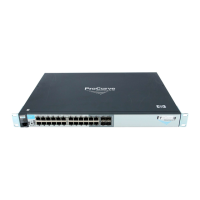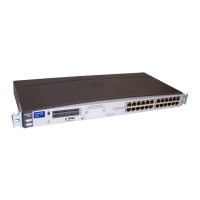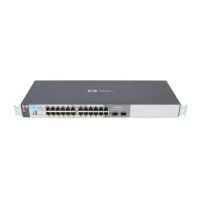Troubleshooting
Unusual Network Activity
Broadcast Storms Appearing in the Network. This can occur when
there are physical loops (redundant links) in the topology.Where this exists,
you should enable MSTP on all bridging devices in the topology in order for
the loop to be detected.
STP Blocks a Link in a VLAN Even Though There Are No Redundant
Links in that VLAN. In 802.1Q-compliant switches MSTP blocks redundant
physical links even if they are in separate VLANs. A solution is to use only one,
multiple-VLAN (tagged) link between the devices. Also, if ports are available,
you can improve the bandwidth in this situation by using a port trunk. Refer
to “Spanning Tree Operation with VLANs” in the chapter titled “Static Virtual
LANs (VLANs)” in the Advanced Traffic Management Guide for your switch.
Fast-Uplink Troubleshooting. Some of the problems that can result from
incorrect usage of Fast-Uplink MSTP include temporary loops and generation
of duplicate packets.
Problem sources can include:
■ Fast-Uplink is configured on a switch that is the MSTP root device.
■ Either the Hello Time or the Max Age setting (or both) is too long on one or
more switches. Return the
Hello Time and Max Age settings to their default
values (2 seconds and 20 seconds, respectively, on a switch).
■ A “downlink” port is connected to a switch that is further away (in hop
count) from the root device than the switch port on which fast-uplink
MSTP is configured.
■ Two edge switches are directly linked to each other with a fast-uplink
(Mode =
Uplink) connection.
■ Fast uplink is configured on both ends of a link.
■ A switch serving as a backup MSTP root switch has ports configured for
fast-uplink MSTP and has become the root device due to a failure in the
original root device.
SSH-Related Problems
Switch access refused to a client. Even though you have placed the cli-
ent’s public key in a text file and copied the file (using the copy tftp pub-key-
file command) into the switch, the switch refuses to allow the client to have
access. If the source SSH client is an SSHv2 application, the public key may
be in the PEM format, which the switch (SSHv1) does not interpret. Check the
SSH client application for a utility that can convert the PEM-formatted key
into an ASCII-formatted key.
C-19
